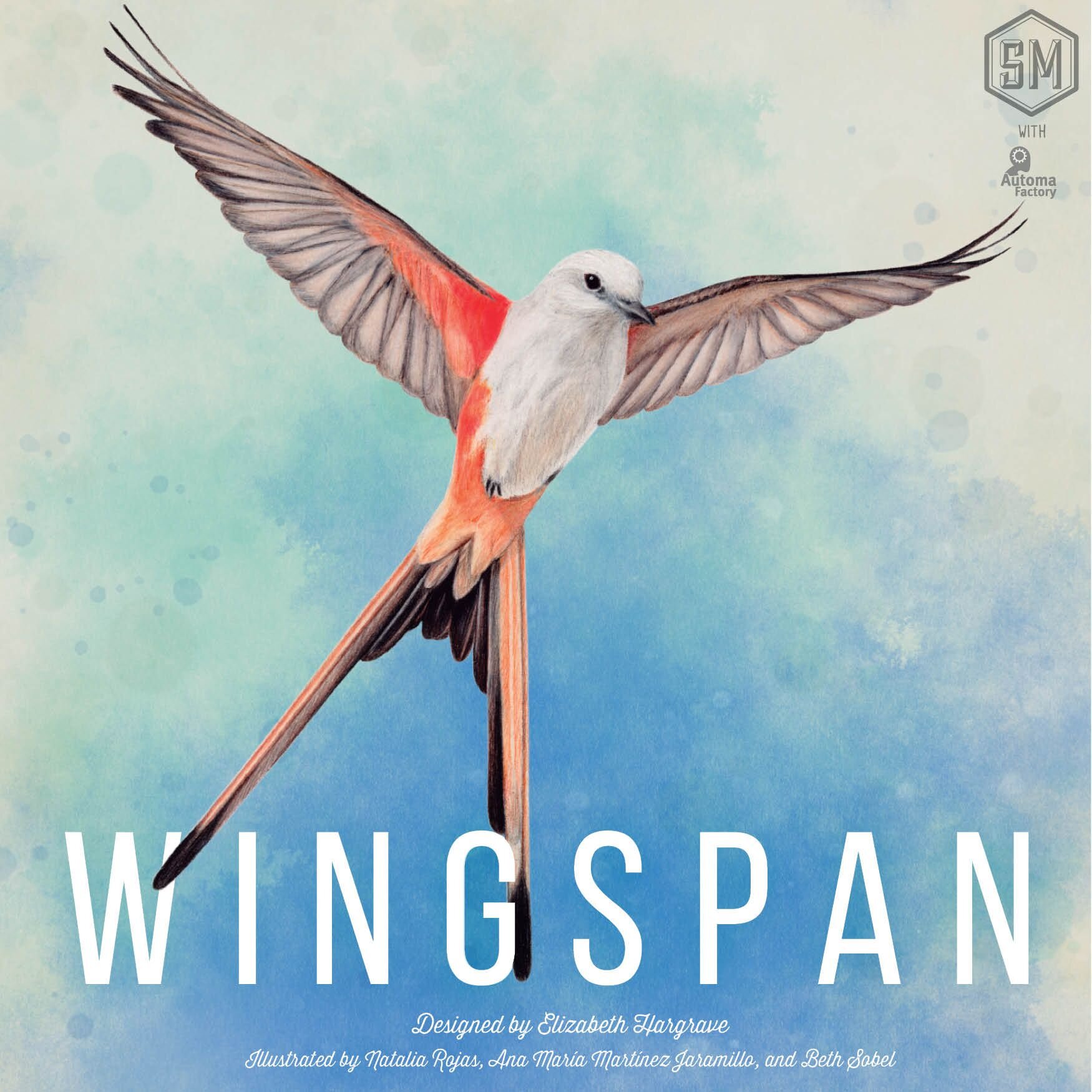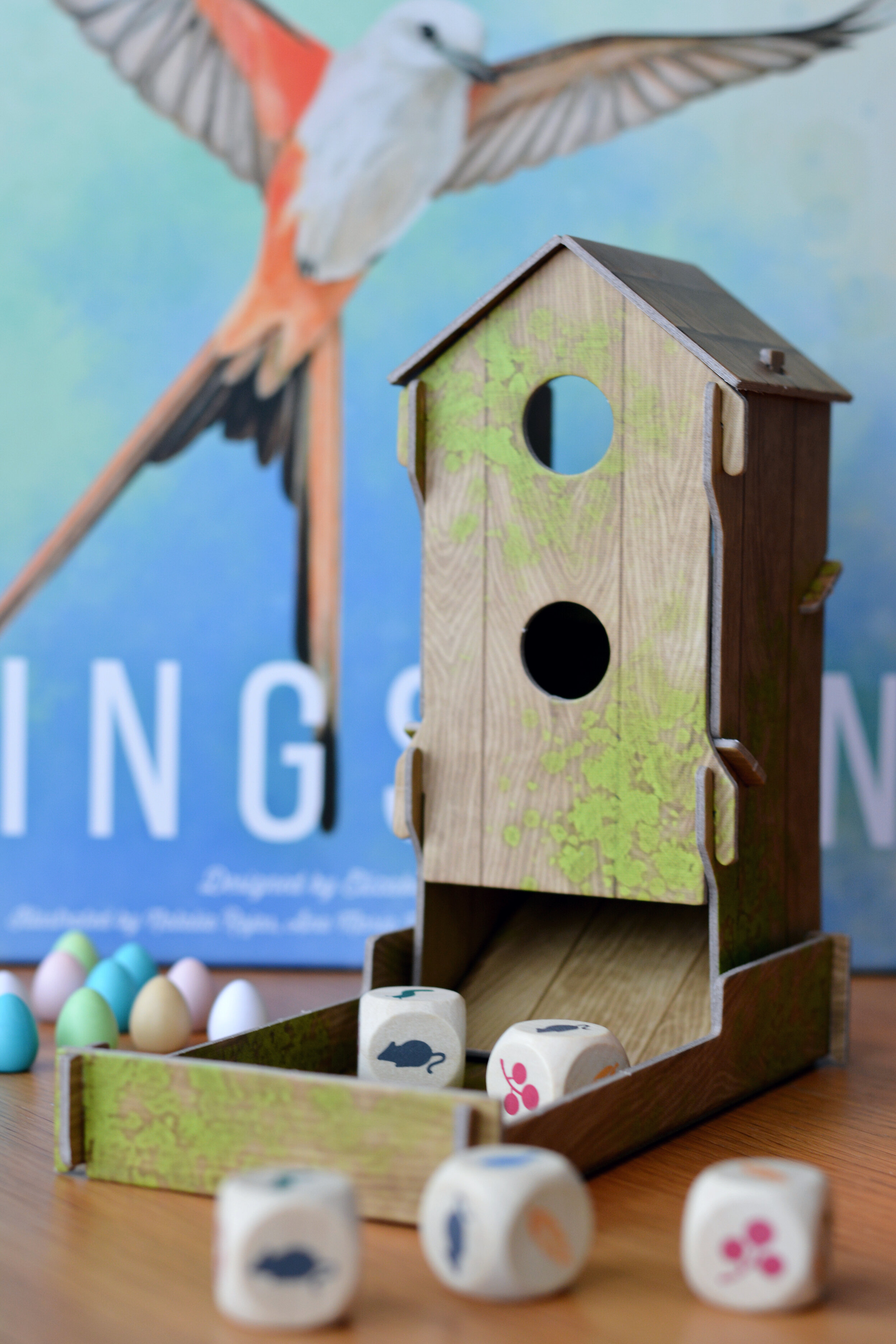Wingspan Review
Image: Stonemaier Games
INTRODUCTION
Picture the following. It is nearing the end of 2018; outside temperatures are in excess of – 20 degrees Celsius. Darkness prevails both in the sky and in the hearts of men; the sun and the moon has been consumed by Fenrir. If you had told me back then, that a cheerful board game about attracting birds to your aviary from first time designer Elizabeth Hargrave would become a worldwide sensation, then I would probably have dismissed your ideas as little more than fever dreams. Well, the egg is certainly planted firmly on my face because this is in fact the fairy tale about a little board game you might have heard of named Wingspan. In early 2019, publisher Stonemaier Games released the aforementioned title unto the masses; the response was a (almost) unified tribute song of praise from both critics and consumers alike. So much so, that the initial print-run turned out to be nowhere near sufficient in terms of market demand. This led to a situation resembling a storm in a tea-kettle within the board game community, but that is beside the point. Now well into its third print-run, Wingspan continues to fascinate the casual crowd and hardened board game veterans alike.
COMPONENTS
Photo: Fredrik Schulz
Finely produced components does not necessarily equal a great board game, there is however no denying the fact that Wingspan is one lavish board game production throughout. Every single piece feels like a luxury item; from the linen finished rule books to the beautiful bird illustrations on each and every one of the 170 included cards. The illustrations by artists Ana Maria Martinez Jaramillo, Natalia Rojas and Beth Sobel are reminiscent of the bird illustrations one would find in an encyclopaedia, highly detailed images bursting with colour which captures the imagination and curiosity of the reader. If that was not enough, the game even includes a dice tower shaped like an actual bird-feeder which when disassembled fits right back in the box. Is it a necessity? Absolutely not by any stretch of the imagination. Do I love using it? Every. Single. Time.
This level of detail extends to the individual player boards, which are designed to represent leather-bound books that you unfold in order to place down the bird cards you acquire during the course of the game. The board is divided into three main rows, each representing a habitat that certain birds can reside in. The level of detail and quality in Wingspan is something I have not seen in quite some time, off the top of my head the most recent board game I can think off would be Mechs Vs Minions.
OVERVIEW
At its core, Wingspan is a tableau and engine builder. At the start of the game players are dealt a hand of five bird cards. From this selection you will have to decide which ones to keep as your starting hand, paying one food token for each card you decide to hold on to. This mechanism is reminiscent of the initial card draft in Terraforming Mars, where you must make a tough decision between starting capital versus a more advantageous hand of cards. Each player is also dealt two bonus cards of which they will choose to keep one face-down. These cards provide you with possibly end-of-game victory points, provided you can fulfil the criteria of said card. Some reward you for having a certain number of birds in a habitat, others may provide you with points based on type of colour or name of your birds in the aviary. I like it when a board game provides you with a starting point to formulate a strategy, the bonus cards are especially helpful to new players who otherwise might be a bit overwhelmed.
The game features over 170 unique, beautifully illustrated bird cards. Photo: Fredrik Schulz
The game is played over a series of four rounds, each consisting of eight to five turns as the game progresses. On any given turn you will choose a single action to perform: place a bird on your aviary, gain food, lay eggs or draw new bird cards from the deck. On paper, this seems simple enough. But as we all know, looks can be deceiving and in the case of our review subject there is more to the design than meets the eye. Wingspan is one of those board games that manages to strike a near perfect balance between rules complexity versus depth of choice. Nearly all bird cards have an associated special ability, which triggers upon the player taking a habitat action. Not only is it the case, that placing one of your action cubes in the forest, grasslands or wetlands allows you to collect the related reward of the chosen habitat. Performing this action also grants you the opportunity to activate the bird cards that are positioned in that row of your player board. You move the action cube from right to left, activating the bird card powers one at the time until you reach the end of the row. This leads to a world of possibilities in terms of forming a strategy. For example, some birds can provide food tokens when activated. Positioning those type of birds in the forest habitat means that taking the Gain food action will result in a greater profit, earning you a larger quantity of food which in turn allows you to play down more exotic birds. To construct an efficient game engine, you need to acquire bird cards that synergise with the inherent effect of the three habitats on your player board.
The catch though, is that all the actions are intertwined with one another. Playing bird cards into your aviary requires food, which you collect from activating the forest habitat. But you need several birds positioned in the forest section of your player board in order to acquire larger quantities of food and be efficient as each round result in fewer and fewer available turns. This symbiotic relationship between the various actions quickly becomes a classic case of Catch 22. Also, you will need birds that reside in the grassland’s habitat for you to collect eggs. Not only are they worth victory points at the end of the game, eggs also act as an in-game currency. When playing down bird cards in the higher tiers of each habitat, you will need to discard not just food tokens but also eggs. Again, the game has you constantly making tough decisions but in a good way much like the board game designs by Reiner Knizia.
End of round goal tiles. Photo: Fredrik Schulz
From a strategical point-of-view, another aspect of the game design that players need to take into consideration is the end-of-round bonus goals. There are eight different tiles to choose from, each depicting a condition that needs to be fulfilled for players to be eligible to compete for additional victory points. The target goals of the bonus tiles range from having the greatest number of birds in a specific habitat, to total number of eggs on a bird nest. These end-of-round goals provides players with tactical considerations, “Do I pursue the current goal, or should I instead focus on the upcoming round which might better suit the cards in my tableau?”.
THE SOLO MODE
In keeping with tradition the Wingspan solo mode was designed by the creative team at the Automa Factory. As a multiplayer experience, Wingspan is very much a classic example of “multiplayer solitaire” as there is little to no direct player interaction to be had. The only instance would be if someone picks a specific bird card that you have been eyeing, otherwise it is most definitely the case that everyone is heads-down whilst focusing on optimizing their own tableau. Therefore, I figured Wingspan would be a prime candidate for the Automa Factory treatment. Much like their previous design work, the Automa i.e. artificial opponent in Wingspan is governed by a deck of cards, each one being divided into rows representing the game rounds. On the automated player’s turn, the top card of the solo deck is revealed and resolved. The symbols on the Automa cards indicate what action the artificial player will execute, like collecting eggs or adding new bird cards to its collection.
Automa cards. Photo: Fredrik Schulz
Unlike the human player, the automated opponent in Wingspan does not have an actual player mat to place down birds and eggs on. Instead, the Automa relies on a starting base value for the different end-of-round goals. For example, if the first bonus-tile stipulates having the most birds in the forest habitat, then the provided player aid will tell you that the Automa starts the current round with two “birds” (the birds are in fact represented by a fixed numerical value and possibly additional wooden cubes). This number may increase or decrease depending on the cards you draw from the Automa deck. This simulates the growth of the aviary as the game progresses. If the aforementioned tile had been assigned the third round instead of the first, then the Automa’s starting base value might have been five birds instead of two, indicating that the game state has changed over the course of previous rounds.
FINAL THOUGHTS
Wingspan manages to strike a near perfect balance between rules and game complexity, in the same way as many of Knizia’s designs. The fact that a player performs a single action out of a total of four may in theory seem borderline simplistic, at a cursory glance it would be easy to dismiss Wingspan as having no depth to it. But once you start to play you will quickly realize that there is so much more to this game than meets the eye in terms of complexity. You always feel like there is not enough time to do all the things you want to accomplish. “If I only had one more turn to gather food tokens, then I could place this bird in the forest habitat and in the process claim the current end of round goal” is a phrase I found myself uttering to myself on more than one occasion while solo playing Wingspan.
This game has been showered with accolades and for good reason. I have introduced it to newcomers and seasoned board game veterans alike, all have thoroughly enjoyed the experience. Wingspan is a triumph on so many levels and I highly recommend it even if you are only going to play it solitaire, it really is that good of a board game design.




